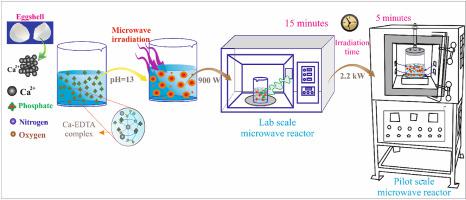当前位置:
X-MOL 学术
›
Ceram. Int.
›
论文详情
Our official English website, www.x-mol.net, welcomes your
feedback! (Note: you will need to create a separate account there.)
Optimization of a lab scale and pilot scale conversion of eggshell biowaste into hydroxyapatite using microwave reactor
Ceramics International ( IF 5.1 ) Pub Date : 2020-11-01 , DOI: 10.1016/j.ceramint.2020.06.288 D. Muthu , G. Suresh Kumar , V.S. Kattimani , V. Viswabaskaran , E.K. Girija
Ceramics International ( IF 5.1 ) Pub Date : 2020-11-01 , DOI: 10.1016/j.ceramint.2020.06.288 D. Muthu , G. Suresh Kumar , V.S. Kattimani , V. Viswabaskaran , E.K. Girija

|
Abstract The high demand for synthetic hydroxyapatite for biomedical applications is on the rise day by day at the same time, there is a pressing need for producing hydroxyapatite (HA) at an economically viable cost to make the treatment affordable to everyone. In order to meet this objective, recycling of waste to value added products and cost effective methods suitable for scaling up the process are being attempted by researchers. In this report, an attempt has been made to optimize the parameters for the synthesis of nano HA from eggshell biowaste using well explored microwave method by employing a lab scale and pilot scale microwave reactors. Several parameters such as pH, organic modifier concentration and microwave power against volume of the reaction mixture has been studied from the view point of enhancing the yield of the product. The preliminary experiments done using lab scale reactor helped the optimization of pH and EDTA concentration. From the lab scale experiments, we found that the yield was directly proportional to the microwave power. The parameters optimized in the lab scale has been carried over to the pilot scale reactor. The results from pilot scale reactor revealed that although the microwave power from pilot scale reactor is considerably higher than that of the maximum power (900 W) of the lab scale reactor there is no significant difference in the yield of the product but the microwave irradiation time has reduced considerably which is almost in proportion to the power of the reactor. Parameters optimized from these batch processes will be useful for devising new scaling up process such as continuous flow methods.
中文翻译:

使用微波反应器优化实验室规模和中试规模的蛋壳生物废物转化为羟基磷灰石
摘要 对用于生物医学应用的合成羟基磷灰石的高需求与日俱增,同时迫切需要以经济可行的成本生产羟基磷灰石 (HA),以使每个人都能负担得起治疗。为了实现这一目标,研究人员正在尝试将废物回收为增值产品以及适合扩大该过程的具有成本效益的方法。在本报告中,通过采用实验室规模和中试规模的微波反应器,尝试使用经过充分探索的微波方法来优化从蛋壳生物废物合成纳米 HA 的参数。从提高产品收率的角度研究了几个参数,例如 pH 值、有机改性剂浓度和微波功率与反应混合物体积的关系。使用实验室规模的反应器进行的初步实验有助于优化 pH 值和 EDTA 浓度。从实验室规模的实验中,我们发现产量与微波功率成正比。在实验室规模中优化的参数已转移到中试规模的反应器中。中试反应器的结果表明,虽然中试反应器的微波功率远高于实验室规模反应器的最大功率(900 W),但产品的产率没有显着差异,但微波辐射时间已大大减少,这几乎与反应堆的功率成正比。从这些批处理过程中优化的参数将有助于设计新的放大过程,例如连续流方法。
更新日期:2020-11-01
中文翻译:

使用微波反应器优化实验室规模和中试规模的蛋壳生物废物转化为羟基磷灰石
摘要 对用于生物医学应用的合成羟基磷灰石的高需求与日俱增,同时迫切需要以经济可行的成本生产羟基磷灰石 (HA),以使每个人都能负担得起治疗。为了实现这一目标,研究人员正在尝试将废物回收为增值产品以及适合扩大该过程的具有成本效益的方法。在本报告中,通过采用实验室规模和中试规模的微波反应器,尝试使用经过充分探索的微波方法来优化从蛋壳生物废物合成纳米 HA 的参数。从提高产品收率的角度研究了几个参数,例如 pH 值、有机改性剂浓度和微波功率与反应混合物体积的关系。使用实验室规模的反应器进行的初步实验有助于优化 pH 值和 EDTA 浓度。从实验室规模的实验中,我们发现产量与微波功率成正比。在实验室规模中优化的参数已转移到中试规模的反应器中。中试反应器的结果表明,虽然中试反应器的微波功率远高于实验室规模反应器的最大功率(900 W),但产品的产率没有显着差异,但微波辐射时间已大大减少,这几乎与反应堆的功率成正比。从这些批处理过程中优化的参数将有助于设计新的放大过程,例如连续流方法。











































 京公网安备 11010802027423号
京公网安备 11010802027423号